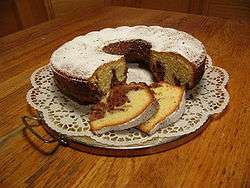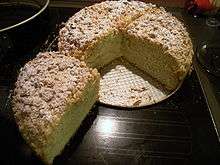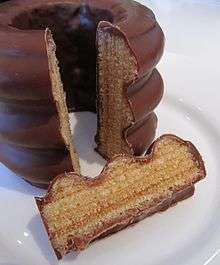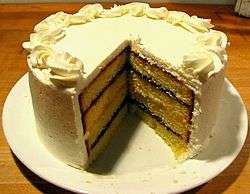Kuchen
 Marmorkuchen | |
| Type | Desserts and pastries |
|---|---|
| Place of origin | Germany |
|
| |
Kuchen (German pronunciation: [ˈkuːxən]), the German word for cake, is used in other languages as the name for several different types of savory or sweet desserts, pastries, and gateaux. Most Kuchen have eggs and flour as common ingredients while also, but not always, including some form of sweetener and/or fat. In Germany it is a common tradition to invite friends over to one's house or to a cafe between noon and evening to drink coffee and eat Kuchen ("Kaffee und Kuchen"[1][2]).
The term itself may cover as many distinct desserts as its English counterpart "cake". However, the word "cake" covers both Kuchen and Torte, sometimes confused with one another. The key difference being that a Torte is a Kuchen that is decorated or layered with cream, frosting, ganache, or fruit based filling after baking. A Kuchen is typically less decorative or fancy in nature. Examples of a Torte made from a base Kuchen include the Jewish Palacsinken Torte[3] and Mohn Torte (or Kindli).
Varieties[4]

- A pie-like pastry, with a thick, "cakey" crust and a sweet custard based or chopped fruit topping, known as an Obstkuchen or a type of fruit cake. This variation sometimes has a sweet icing or decorative cream topping. Variations include Erdbeerkuchen and Apfelkuchen.
- A rolled-pastry, specifically called Kuchenrolle, with a long spiral of dough sometimes filled with cream and/or jam, rolled, baked and then sliced to serve. This is sometimes known as a nut roll when nuts are added.
- A coffee cake-like pastry, marbled with veins and pockets of cinnamon, baked throughout; its primary components are butter and sugar. A marble cake or pound cake would be variations of this form, specifically known as a Marmorkuchen and Rührkuchen respectively. Streuselkuchen is a variation of this form.
- A cheese cake-like pastry, specifically called Käsekuchen, with a yeast raised crust, sometimes filled with fruit (cherry is most popular), and a creamy filling made from the German cheese Quark.
- A pan-fried pastry, specifically known as Pfannkuchen, a German pancake thicker than French Crepes and often filled with a sweet or savory filling. An egg based variation is called Eierkuchen.
- A layered pastry, commonly known as a Baumkuchen, made over a spit while brushing on layers of batter.
- A sheet-cake-like pastry, specifically known as Blechkuchen, with variations similar to other forms of Kuchen with the key difference being that this form is baked on a sheet. Can be butter based, known as Butterkuchen, or filled with fruit. Lebkuchen is one such variation commonly made during Christmas.
Kuchen also does not have to fall under a sweet category as there are savory variations of it as well. These are called Pikante Kuchen, with examples such as Zwiebelkuchen, Speckkuchen, and KartoffelKuchen (often paired with fresh wine or beer).
Jewish Variations and Traditions
In the United States, back when Jewish immigrants were first arriving in the country, many of the recipes that they brought with them utilized dried fruits as it was difficult to come across fresh ones in their home countries. One that was particularly favored is compote. Desserts have long since changed to become more sophisticated as fresh fruits are now abundant.[5]
Lekach is a Jewish honey cake of German origin. It comes from Lebkuchen, or honey-sweetened gingerbread. This has roots from as early as the twelfth century, when it was customary for boys attending heder (school for Jewish children) to bring a piece of honey cake to the first day of school.[3]
Rugelach is a form of the rolled-pastry variation of Kuchen. They are usually filled with nuts and raisins, with a pastry composed of cheese curds and sour cream.[3]
Mandelbrot, which literally means almond bread, resembles and is served toasted like bread despite not being made of bread dough. They are commonly paired with sweet wine, and when compared to Biscotti they are more "cakey" and softer.
Cultural Influence
.jpg)
Kuchen desserts are presumably handed down from people of German heritage and as such are often popular in many areas of German settlement in the United States, particularly Montana, North Dakota, South Dakota, Kentucky, Indiana, Minnesota, and Wisconsin.
Kuchen was introduced into Chilean cuisine when German immigrants settled southern Chile in the 1850s. Kuchen in Chile usually have fruits, such as apples, strawberries or murtas. Nontraditional Chilean Kuchen with walnuts are sometimes offered. Now Kuchen are found in many Chilean bakeries and in many of the larger supermarkets.
In Brazil it is called "cuca", or less commonly, "cuque" and can be found in areas of German settlement, like Rio Grande do Sul, Paraná, Santa Catarina and São Paulo states.
The French quiche was influenced by the savory version of German Kuchen and is now known as a traditional French dish.
In 2000, a Kuchen was designated the state dessert of South Dakota.[6] Introduced by German settlers in the 1870s, Kuchen is now found throughout the state and can be found in peach, apple, prune and chocolate pecan variations.[7]
See also
- Backe, backe Kuchen
- German cuisine
- Austrian cuisine
- Saxon cuisine
- List of German desserts
-
 Food portal
Food portal
Notes
- ↑ Wurz, H. (1994). "Cuisine: Kaffee und Kuchen". German life. 1 (2): 50.
- ↑ Hudgins, Sharon (2015). "COFFEE TAKES THE CAKE: The German Tradition of 'Kaffee und Kuchen'". German Life. 21 (5): 50–52.
- 1 2 3 Roden, C. (1996). The Book of Jewish Food: An Odyssey from Samarkand to New York. Alfred a Knopf Incorporated.
- ↑ Hofmann, M.; Lydtin, H. (1977). Bayerische Kochbuch. München: Birken-Verlag.
- ↑ Newman, B. (1997). "The Jewish Kitchen: Fresh summer fruits sparkle in kuchen and coffee cake". MetroWest Jewish News. L1 (25): 48.
- ↑ Grant, Jason M. (2011). "State Seal and Emblems" (PDF). South Dakota Legislative Manual 2011. State of South Dakota. p. 239. Retrieved 6 July 2012.
- ↑ Long, D. T. (2011). "Hometown desserts: regional favorites that will sate your sweet tooth across the U.S. Just remember to save room". TASTE OF TRAVEL. National Geographic Traveler. 28 (5): 43.


